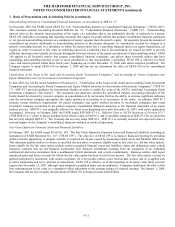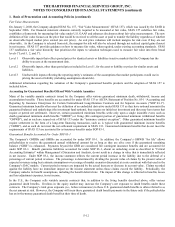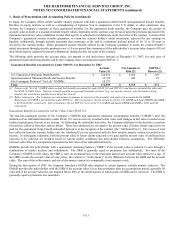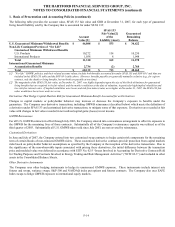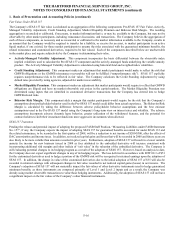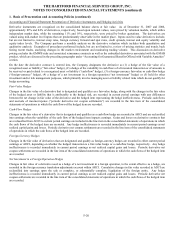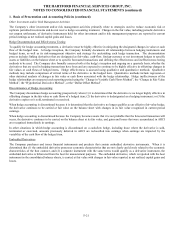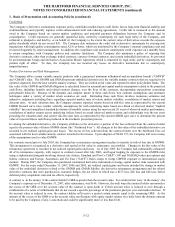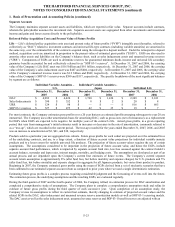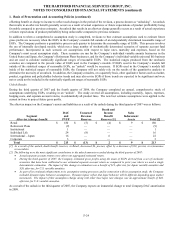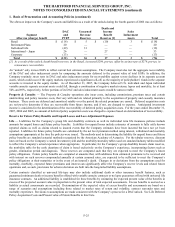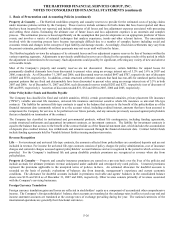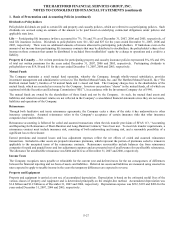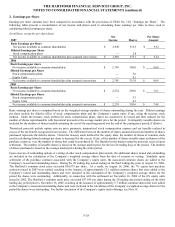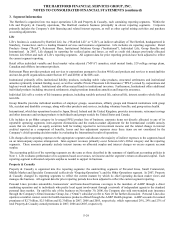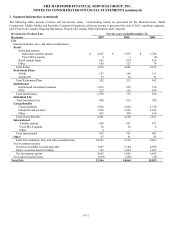The Hartford 2007 Annual Report Download - page 198
Download and view the complete annual report
Please find page 198 of the 2007 The Hartford annual report below. You can navigate through the pages in the report by either clicking on the pages listed below, or by using the keyword search tool below to find specific information within the annual report.
THE HARTFORD FINANCIAL SERVICES GROUP, INC.
NOTES TO CONSOLIDATED FINANCIAL STATEMENTS (continued)
F-21
1. Basis of Presentation and Accounting Policies (continued)
Other Investment and/or Risk Management Activities
The Company’ s other investment and/or risk management activities primarily relate to strategies used to reduce economic risk or
replicate permitted investments and do not receive hedge accounting treatment. Changes in the fair value, including periodic derivative
net coupon settlements, of derivative instruments held for other investment and/or risk management purposes are reported in current
period earnings as net realized capital gains and losses.
Hedge Documentation and Effectiveness Testing
To qualify for hedge accounting treatment, a derivative must be highly effective in mitigating the designated changes in value or cash
flow of the hedged item. At hedge inception, the Company formally documents all relationships between hedging instruments and
hedged items, as well as its risk-management objective and strategy for undertaking each hedge transaction. The documentation
process includes linking derivatives that are designated as fair-value, cash-flow, foreign-currency or net investment hedges to specific
assets or liabilities on the balance sheet or to specific forecasted transactions and defining the effectiveness and ineffectiveness testing
methods to be used. The Company also formally assesses both at the hedge’ s inception and ongoing on a quarterly basis, whether the
derivatives that are used in hedging transactions have been and are expected to continue to be highly effective in offsetting changes in
fair values or cash flows of hedged items. Hedge effectiveness is assessed using qualitative and quantitative methods. Qualitative
methods may include comparison of critical terms of the derivative to the hedged item. Quantitative methods include regression or
other statistical analysis of changes in fair value or cash flows associated with the hedge relationship. Hedge ineffectiveness of the
hedge relationships are measured each reporting period using the “Change in Variable Cash Flows Method”, the “Change in Fair Value
Method”, the “Hypothetical Derivative Method”, or the “Dollar Offset Method”.
Discontinuance of Hedge Accounting
The Company discontinues hedge accounting prospectively when (1) it is determined that the derivative is no longer highly effective in
offsetting changes in the fair value or cash flows of a hedged item; (2) the derivative is dedesignated as a hedging instrument; or (3) the
derivative expires or is sold, terminated or exercised.
When hedge accounting is discontinued because it is determined that the derivative no longer qualifies as an effective fair-value hedge,
the derivative continues to be carried at fair value on the balance sheet with changes in its fair value recognized in current period
earnings.
When hedge accounting is discontinued because the Company becomes aware that it is not probable that the forecasted transaction will
occur, the derivative continues to be carried on the balance sheet at its fair value, and gains and losses that were accumulated in AOCI
are recognized immediately in earnings.
In other situations in which hedge accounting is discontinued on a cash-flow hedge, including those where the derivative is sold,
terminated or exercised, amounts previously deferred in AOCI are reclassified into earnings when earnings are impacted by the
variability of the cash flow of the hedged item.
Embedded Derivatives
The Company purchases and issues financial instruments and products that contain embedded derivative instruments. When it is
determined that (1) the embedded derivative possesses economic characteristics that are not clearly and closely related to the economic
characteristics of the host contract, and (2) a separate instrument with the same terms would qualify as a derivative instrument, the
embedded derivative is bifurcated from the host for measurement purposes. The embedded derivative, which is reported with the host
instrument in the consolidated balance sheets, is carried at fair value with changes in fair value reported in net realized capital gains and
losses.


